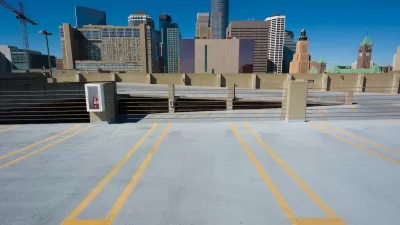Minneapolis is mired in a debate over the role the automobile should play in the city's mobility mix. Many neighborhoods want to reduce surface parking and ease minimum parking requirements, but people still view the city as “a car town.”
Minneapolis seems stuck between a car-dependent past and a future of increased walking, biking, and transit use. Caught in the middle are city leaders and planners, who are working to loosen parking requirements and reduce surface lots while facing complaints over reduced availability.
"Striking a balance between too much and too little parking is a growing quandary, particularly as more residents bike, walk and take transit while also holding onto their cars," writes Eric Roper. Despite astonishing growth in the percentage of trips taken by bike, transit, and on foot from 2000-2010, the percentage of carless households in Minneapolis actually declined during that period.
“The first reaction of most neighborhoods would be that there’s not enough parking,” said Ted Tucker, president of the city planning commission. “But the trouble with that is, of course, the city may devote too many resources to parking automobiles and not enough to making life pleasant for pedestrians and bicyclists.”
FULL STORY: Minneapolis seeks more people, not more cars

Study: Maui’s Plan to Convert Vacation Rentals to Long-Term Housing Could Cause Nearly $1 Billion Economic Loss
The plan would reduce visitor accommodation by 25,% resulting in 1,900 jobs lost.

North Texas Transit Leaders Tout Benefits of TOD for Growing Region
At a summit focused on transit-oriented development, policymakers discussed how North Texas’ expanded light rail system can serve as a tool for economic growth.

Why Should We Subsidize Public Transportation?
Many public transit agencies face financial stress due to rising costs, declining fare revenue, and declining subsidies. Transit advocates must provide a strong business case for increasing public transit funding.

How to Make US Trains Faster
Changes to boarding platforms and a switch to electric trains could improve U.S. passenger rail service without the added cost of high-speed rail.

Columbia’s Revitalized ‘Loop’ Is a Hub for Local Entrepreneurs
A focus on small businesses is helping a commercial corridor in Columbia, Missouri thrive.

Invasive Insect Threatens Minnesota’s Ash Forests
The Emerald Ash Borer is a rapidly spreading invasive pest threatening Minnesota’s ash trees, and homeowners are encouraged to plant diverse replacement species, avoid moving ash firewood, and monitor for signs of infestation.
Urban Design for Planners 1: Software Tools
This six-course series explores essential urban design concepts using open source software and equips planners with the tools they need to participate fully in the urban design process.
Planning for Universal Design
Learn the tools for implementing Universal Design in planning regulations.
Ascent Environmental
Borough of Carlisle
Institute for Housing and Urban Development Studies (IHS)
City of Grandview
Harvard GSD Executive Education
Toledo-Lucas County Plan Commissions
Salt Lake City
NYU Wagner Graduate School of Public Service





























